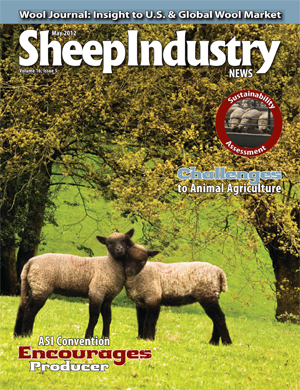K-State Shows Off New Sheep and Meat Goat Facility
BETH RIFFEL
Reprinted from the Midwest Producer
(May 1, 2012) Although it has been decades in the making, sheep and goat producers got the first look at the new Sheep and Meat Goat Center unveiled on the Kansas State University (KSU) campus at the open house and ribbon cutting held March 3.
Representatives from state and national sheep and goat industry groups were on hand for the event as well as representatives from the Kansas Legislature. Ken Odde, KSU department head of theAnimal Science and Industry, thanked the many people who made this one-time dream a workable reality.
Brian Faris, Ph.D., state sheep and goat specialist, addressed the crowd assembled in the new facility, and explained that the development and design of the $1.68 million facility was an intensive planning process that included much input from producer groups as well as visiting other university research facilities, determining what would yield the most workable and effective building that would facilitate both practical educational experiences as well as accommodate research programs.
“We’ve talked to a lot of universities and looked at what they have,” Faris explained. “We saw what was working and what they would do differently.”
Burdell Johnson, a North Dakota sheep producer who spoke on behalf of the American Sheep Industry Association, noted that recent budget reductions have impacted the industry negatively. “I applaud K-State for this facility,” Johnson said.
“While a lot of universities are doing away with sheep programs all together, you are placing a greater emphasis on them.” He added that sheep producers nationally and internationally would benefit from the research that happens in Manhattan. “Research isn’t contained by state lines.”
It was noted by several speakers that while the sheep and goat industries may be small in Kansas, compared to the beef business, the national and international importance is significant, being one of the most widely consumed meats in the world.
Kim Ketcham, Ketcham Equipment from Edwardsville, Ill., was on hand for the ribbon cutting ceremony. Ketcham provided $40,000 worth of kidding and lambing jugs and feeders for the facility, all painted the traditional K-State purple. The Livestock Marketing Information Center board also financially supported the unit with funds for equipment.
The facility includes a complete working setup. There is a raceway and chute system leading up to a working area that includes a squeeze chute and an elevated platform to aid with sonogram procedures as well as artificial insemination.
“We can place all the animals that we’d need to work in a day inside, and never have to leave the climate-controlled building,” Faris said during the formal tour of the facility.
Odde and Faris indicated that their expectations were that production-related research, including feeding studies and reproductive efficiencies would be the focus – things that would undoubtedly benefit producers who are making a living with the animals.
“We intend to strengthen the area of undergraduate research and strengthen our student recruitment as well,” Odde said.
It is also expected that the unit would host collegiate, junior college and high school livestock judging teams that need the opportunity to evaluate sheep and goat classes prior to national contests. Faris pointed out that the buildings were designed under roof with plenty of lighting to accommodate workout schedules.
Faris explained that the principal production scheme at the unit would focus on an accelerated lambing and kidding system, achieving three lamb crops in two years. “We know that producers are getting it done, and if we can’t do it here in this system with the availability of labor, no one should be able to do it.”
While the building is impressive and appears to be complete, it was explained that some parts of the building are only partially complete. Kitchen facilities adjacent to the classroom/meeting area, a procedure room and a laboratory area for the facility are in the building layout and will be finished as additional funding is secured.
The facility’s classroom space will also be available to host meetings. It was pointed out that the availability and ease of parking would make the unit an attractive meeting option for groups who did not want to gather on the central campus.
Funding for the facility came from three primary sources: the sale of the old sheep unit pasture to the KSU Foundation, a commitment of funds from the college and the sale of easements to Weststar Corp.
Faris projected that the sheep and goat unit would be able to hold 150 ewes and 75 does.


